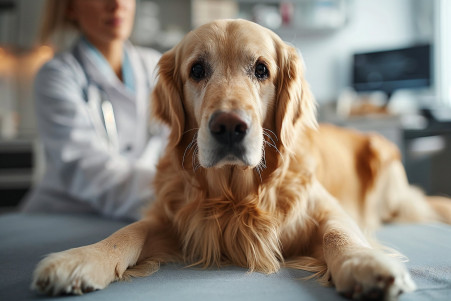Signs of Trouble After Dog Neutering: What to Look For
20 March 2024 • Updated 20 March 2024

If your dog has recently been neutered, it's important to know what to look for in terms of warning signs that could indicate a post-operative problem or other concern. Signs of trouble after dog neutering may include abnormal swelling or bleeding at the incision site, prolonged periods of lethargy or loss of appetite, vomiting, pain, fever, discharge, or difficulty urinating. If you see any of these signs, you should contact your veterinarian right away, as they may require medical attention.
We will go over the average recovery time for dog neutering and the potential post-operative problems that can arise based on information from veterinary surgical research and clinical experience. This will help you better understand what to look for and how serious it is so that you can help your dog heal successfully and know when to seek help from a professional.
Let's get into the details so that you can make sure your dog stays healthy and happy.
What are the warning signs to look out for after dog neutering?
What Is the Recovery Time for Dog Neutering?
During the first 24 hours after the surgery, dogs may experience some common anesthesia-related symptoms like grogginess, nausea, or restlessness, says the Animal Humane Society's post-operative instructions. However, these side effects should go away after the anesthesia has completely left their system.
To ensure that your dog heals properly, it's important to monitor them closely and limit their physical activity for 10-14 days after the surgery. As the Animal Humane Society points out, excessive activity can lead to swelling, the wound opening up, and other issues that could result in the need for expensive medical treatments.
The incision site should start to heal after a week, although the stitches or staples will likely stay in for 10-14 days before they are taken out, according to veterinarians. Some redness and swelling around the incision is normal at first. However, Embrace Pet Insurance explains that male dogs may continue to mount, roam, or mark for 4-6 weeks after neutering because of the time it takes for their testosterone levels to drop.
The amount of time it takes for dogs to return to their normal levels of activity and exercise can be different for each dog and depends on factors like their size and age. Smaller, younger dogs often recover more quickly and can go back to their normal routines within 1-2 weeks after a neuter, according to Swifto's veterinary advice. On the other hand, larger and older dogs may need 2-3 weeks or longer to recover, especially after more invasive spay surgeries. Your vet's evaluation will be important in determining when your dog can safely start to increase their activity.
Possible Complications and Signs of Infection After Dog Neutering
Although complications from dog neutering are relatively rare, it's important to watch for signs of potential issues that may require veterinary care. Apple Valley Vet lists some of the most common complications as including infection, anesthetic complications, self-trauma, delayed healing, and bleeding or hernias.
Dog owners should watch for redness, swelling, or discharge at the incision site, as these could be signs of an infection. PawSafe also explains that signs of concern include extreme lethargy, loss of appetite, vomiting or diarrhea that lasts for more than 24 hours, and the incision coming open.
According to Dispomed's research, risk factors for complications include patient immunosuppression, lack of aseptic technique, and hypothermia. That said, the overall rate of complications is between 0-32%, with higher rates often seen in younger patients.
Although the idea of complications can be stressful, Apple Valley Vet explains that most dogs will heal well from neutering if they are monitored and cared for properly. It's important to stay on the lookout for any signs of concern and to seek veterinary care if you have any worries.
How to Take Care of Your Dog After Neutering
It is important to follow your vet's instructions to ensure that your dog has a successful recovery after neutering. The Maryland SPCA explains that you should limit your dog's activity for 7-14 days, which means no running, jumping, or rough play.
In order to keep the incision clean, you should not bathe your dog or let the incision get wet for at least 7 days. PetMD suggests using an Elizabethan collar or recovery suit to keep your dog from licking or chewing the area. You should also check the incision daily for any signs of infection, including swelling, redness, or discharge.
It is also important to make sure that your dog is comfortable and pain-free during the recovery process. PetHelpful recommends following your vet's instructions for giving any pain medications that have been prescribed. You should also make sure that your dog has a quiet, comfortable place to rest and recover.
You should also keep an eye on your dog's appetite, water intake, and bowel movements, as PetHelpful points out that it is normal for dogs not to have a bowel movement for a couple of days after surgery. If you notice any changes in your dog's behavior or symptoms, contact your vet immediately.
By making sure that you are following your vet's instructions and taking these steps to ensure that your dog's incision heals properly, you can help make sure that your dog has a successful recovery after neutering.
Long-Term Health Effects of Dog Neutering
The choice to neuter your dog is a big one and the long-term health effects can be very different depending on your dog’s breed, sex, and age at the time of the surgery. As the AKC Canine Health Foundation explains, recent studies have shown that the health effects of neutering are complex and that the risk of certain orthopedic diseases and cancers actually increases in some breeds when dogs are neutered before 6 months of age.
For instance, a study in PMC found that neutering before 6 months of age increased the risk of joint disorders like hip dysplasia and cranial cruciate ligament tear by 4-5 times in Golden Retrievers and doubled the risk in Labrador Retrievers. The same study found that the risk of certain cancers was 3-4 times higher in neutered female Golden Retrievers than in intact females.
On the other hand, the Humane Society of the United States says that neutered and spayed pets live longer with neutered male dogs living 13.8% longer and spayed female dogs living 26.3% longer on average. This is largely because of the decreased risk of reproductive diseases and cancers.
Because these effects are so specific to certain breeds, it’s important to talk to your vet to decide when to neuter your dog based on their specific needs and health history. This way, you can make sure that you’re making the best choice for your dog’s long-term health.
Conclusion: Ensuring a Smooth Recovery for Your Neutered Dog
Neutering your dog is an important step in responsible pet ownership, but it's crucial to monitor for any warning signs during the recovery period. By understanding the typical timeline, potential complications, and best practices for post-operative care, you can help ensure your furry friend has a smooth healing process.
While complications are generally rare, staying vigilant for issues like excessive bleeding, swelling, lethargy, or signs of pain is key. Following your veterinarian's instructions for activity restriction, incision management, and pain medication can go a long way in supporting your dog's recovery.
It's also important to consider the long-term health implications of neutering, which can vary based on factors like breed and age. Consulting with your vet to make an informed decision that prioritizes your dog's individual needs is recommended.
With proper monitoring, care, and open communication with your veterinarian, most dogs recover well from neutering procedures. By remaining attentive and proactive, you can help your beloved companion navigate this important transition smoothly.


